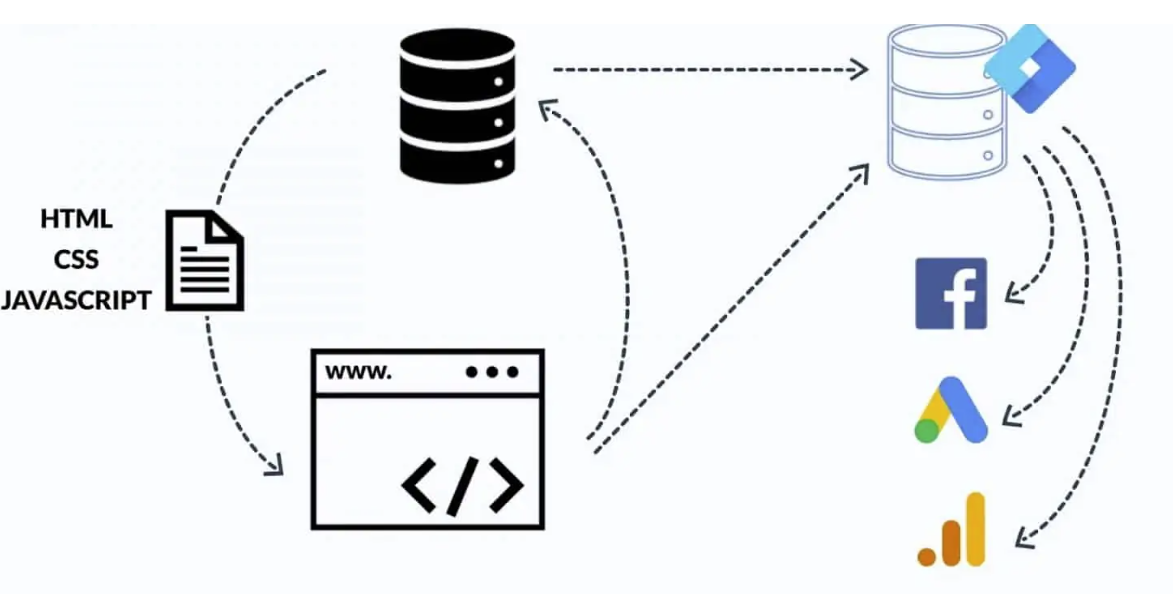Let’s delve into the world of digital analytics and marketing. Two crucial players, Google Analytics 4 (GA4) and server-side Google Tag Manager (GTM), are transforming the way we approach data tracking and analysis. They offer a forward-thinking method to understand customer behaviour, refine marketing strategies, and keep pace with the rapidly evolving digital landscape.
Understanding Server-Side Tracking
Server-side tracking deploys tracking scripts or ad pixels from a server, rather than directly from the user’s web browser. In this setup, the interaction takes place directly between your server and third-party servers such as Google Cloud Platform or Amazon Web Services. The result? No third-party JavaScript code on your website and no third-party cookies in your users’ browsers. This approach allows for more precise data collection and limits disruptions from browser limitations or ad-blocking software.
A Look at Client-Side Tracking
Before we fully comprehend server-side tracking, it’s crucial to grasp client-side tracking. The client-side method runs tracking codes or ad pixels in the user’s browser, communicating directly with third-party servers. While this method is common, it’s increasingly unreliable due to stricter browser restrictions and the proliferation of ad blockers.
Server-Side Tracking on the Rise
The landscape of digital marketing is shifting, with ad blockers and web browser privacy enhancements creating significant challenges for data collection via client-side tracking. Notably, the Brave browser now defaults to blocking Google Analytics and GTM, whilst Safari’s Intelligent Tracking Prevention (ITP) feature restricts third-party cookies. Google also plans to phase out support for third-party cookies. These changes have made client-side tracking less reliable, driving marketers to explore server-side alternatives.
The Benefits of Server-Side Tracking
Server-side tracking offers several compelling advantages:
-
- Accurate Conversion Tracking: Server-side tracking enables API-based conversion tracking, providing a more accurate understanding of conversions compared to traditional browser-based methods.
- First-Party Context: Server-side tracking lets you collect third-party data in the context of first-party data, bypassing some tracking restrictions.
- Tracking Resilience: Unlike client-side tracking, server-side tracking is not blocked by web browsers or ad blockers, ensuring more consistent data collection.
- Data Control: You retain more control over the data sent to third-party vendors
- Improved Website Speed: As marketing and analytics tags are not fired from users’ browsers, website speed can be enhanced.
API-Based Conversion Tracking and Server-Side GTM
Server-side tracking allows for the implementation of API-based conversion tracking, which is less affected by browser-based tracking restrictions and ad blockers. For example, you can leverage Google Ads Conversion API and Facebook Ads Conversion API to provide your ad pixels with more conversion data, thereby boosting the performance of your marketing campaigns.
Server-side tracking can also integrate with Google Tag Manager, enabling server-side tagging. This typically involves running a GTM container in a server-side environment, often referred to as a server-side GTM container.
Find out how to setup GA4 serverside tracking in 10 steps
The Cost of Server-Side Tracking
Despite the numerous advantages, server-side tracking comes at a cost. Google suggests running at least three App Engine instances on the Google Cloud Platform for server-side tracking, which could set you back around $120 per month. The exact cost will depend on your traffic levels and the number of events being tracked.
Nevertheless, for organisations heavily reliant on web analytics for decision making, server-side tracking can offer more reliable data and a better return on investment.
Conclusion
Given the changing landscape of web analytics due to privacy regulations and browser restrictions, server-side tracking has emerged as a promising alternative to client-side tracking. With server-side GTM and GA4, businesses can ensure more robust and accurate data collection, providing deeper insights into user behaviour and campaign performance. Although it comes with additional costs, the advantages make it a worthy investment for businesses serious about their digital marketing efforts.
As always, organisations should carefully consider their specific needs and capabilities when deciding to switch to serverside tracking. Consulting with a digital marketing expert can help clarify the best path forward based on the organisation’s unique circumstances.

